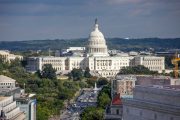
Treasury Secretary Jacob Lew announced on Monday afternoon that his department had sold the remaining shares of GM that it acquired following the forced bankruptcy of the auto giant in 2009, and made the $10.5 billion loss sound like it was a victory:
The President’s leadership in responding to the financial crisis helped stabilize the auto industry and prevent another Great Depression. With the final sale of GM stock, this important chapter in our nation’s history is now closed.
The President understood that inaction could have cost the broader economy more than one million jobs, billions in lost personal savings, and significantly reduced economic production.
As a result of his efforts, which built on those of the previous [Bush] administration, more than 370,000 new auto jobs have been created, and all three U.S. automakers are profitable, competitive and growing.
The president was only too happy to accept the applause and the responsibility for single-handedly returning the entire auto industry to profitability. He said:
I refused to walk away from American workers and an iconic American industry. But in exchange for rescuing and retooling GM and Chrysler with taxpayer dollars, we demanded responsibility and results.
In 2011 we marked the end of an important chapter as Chrysler repaid every dime and more of what it owed the American taxpayers from the investment we made under my administration’s watch. Today we’re closing the book by selling the remaining shares of the federal government’s investment in General Motors.
History records things differently. First of all, the president initially refused to bail out GM in March 2009 but relented only when the company reported that it was weeks away from running out of cash and would be forced to shut down operations. Second, the president had little to do with any retooling that GM did, with the exception of unilaterally firing GM Chairman Rick Waggoner on March 29.
Third, GM was in desperate financial shape long before the start of the Great Recession, having rung up huge losses of $10.6 billion in 2005 and another $38.7 billion in 2007.
In addition, the president failed to distinguish between taxpayer rescue monies and those provided by the Canadian government and the United and Canadian Auto Workers unions’ VEBA (Voluntary Employees Beneficiary Association) fund. GM still owes Canada and the unions.
Finally, the president misspoke once again when noting that Chrysler had “repaid every dime and more of what it owed the American taxpayer.” Chrysler soaked up more than $1 billion of bailout funds with little chance of the American taxpayer ever seeing one thin dime of it.
Aside from these, however, the president’s statement was mostly true.
President Obama added:
When things looked darkest for our most iconic industry, we bet on what was true: the ingenuity and resilience of the proud, hardworking men and women who make this country strong. Today, that bet has paid off. The American auto industry is back.
The president failed to mention that there were other proud, hardworking men and women who owned bonds in the failed GM whose value were decimated in the forced “quickie” Section 363 bankruptcy that left them holding the bag on nearly $172 billion of debt that GM erased in that move.
But once again what the president said was mostly true. He had the GM-funded “independent” Center for Automotive Research (CAR) report to back him up. According to the CAR, if GM and Chrysler had been allowed to go through a normal bankruptcy and reorganization it “would have reduced U.S. employment by 2.631 million jobs in 2009 and 1.519 million jobs in 2010.” It would have cost the government transfer payments (i.e., unemployment benefits and food stamps) along with reduced tax payments into the Treasury and Social Security of more than $105 billion. Hence, says CAR, the modest $10 billion shortfall between what GM received and what GM has returned to the Treasury is really quite modest. In fact, according to the CAR, the bailout of GM resulted in a “768 percent [return] on the investment.”
And, said the center in its press release announcing the study, there were other benefits of the bailout, too, including avoiding a negative “impact on GM and Chrysler retirees, a probable permanent loss of automotive research and product development jobs, and the implications of bankruptcies of this magnitude in 2009 on the confidence of the main street economy of the United States.”
Instead, by circumventing regular bankruptcy procedure, which the center said would have been “a drawn-out, disorderly … proceeding … [that would have led] to a liquidation of the automakers,” the “quick, orderly Section 363 bankruptcy” served GM much better. By shedding $172 billion of its debt (compared to assets of just $82 billion claimed by GM at the time of its filing for bankruptcy) and leaving bondholders with little or nothing, GM not only survived, but prospered, according to CAR.
Little attention was paid to how the industry would have adjusted by following the normal rule of law. According to CAR,
It is true that CAR projects that much of U.S. auto manufacturing employment would have recovered without U.S. government intervention by 2011 or sometime thereafter, but there would have been a decided shift in the location of this employment to the southern portion of the United States….
Results for upper Midwest states such as Michigan, Ohio and Indiana … would have been severe.… Double digit unemployment rates would still exist in these states today.
What CAR is conceding then is that the GM and Chrysler bailouts were also bailouts of union-centric states heavily involved in Obama’s election campaigns. It’s also conceding that, left on its own, the auto industry would have recovered nicely, rapidly, and efficiently by taking advantage of lower wage costs in non-union states in the south.
All in all, then, the bailout of GM and Chrysler served many purposes: It kept a moribund industry afloat with taxpayer monies, it circumvented the rule of law through a Section 363 bankruptcy, and it set a dangerous precedent for the next bailout of an “essential” industry. It helped Obama’s unions, it defrauded bond holders, and rewarded incompetency. It was a victory after all, but not for American citizens or taxpayers.
A graduate of Cornell University and a former investment advisor, Bob is a regular contributor to The New American magazine and blogs frequently at www.LightFromTheRight.com, primarily on economics and politics. He can be reached at [email protected].

